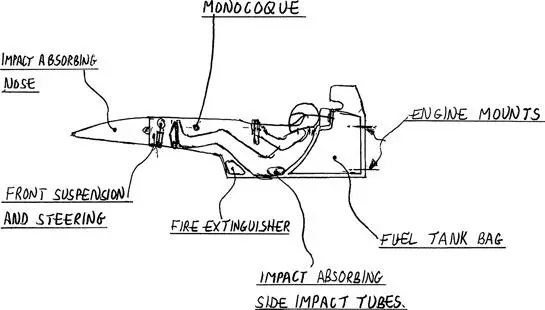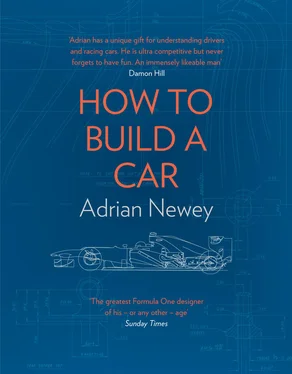Of all these early pioneers, the most buccaneering was Colin Chapman, founder and boss at Lotus and the closest thing I have to a design hero.
Chapman was one of the few who did in fact have aeronautical training, which he used to great effect. He had a tendency, though, to start afresh rather than build on past success, so having won the championship with a car powered by a Cosworth DFV engine in 1968 – the first car to feature that engine – Colin then decided to invest heavily in four-wheel drive, a lame duck of an idea that resulted in cars that were way too heavy to be competitive.
Another blind alley in the form of an inefficient gas turbine car meant that by 1970 Lotus were still racing the same car that had won the 1968 championship and were struggling to catch up. The Lotus 72 of mid-1970 was a gem that held them high through to 1972, followed by a further series of blind alleys. It wasn’t until the Lotus 78, the ground-effect car, that they became competitive again. And though they didn’t win the championship that year, the following year’s car, the Lotus 79, dominated 1978.
After that, however, Lotus returned to blind alleys. When Gordon Murray of Brabham introduced pullrod suspension to replace the old rocker system, and John Barnard at McLaren replied with a pushrod set-up – both of which helped cars cope with the huge loads generated by downforce – the Lotus answer was to develop a chassis with a separate aerodynamic shell linked directly to the wheels, so it transmitted all its downforce straight to the wheels, not through the suspension. It didn’t really work and, to add insult to injury, it was banned.

Figure 4:The monocoque with its many components.
Personally, I would have been intrigued to meet Chapman. He was a fascinating character, a real innovator. It was he who espoused the idea that high power was less important than good handling. He had a talent for applying advances made in disciplines other than F1. So, for example, he’s often credited as being the first to introduce monocoque construction, where instead of constructing a chassis from steel tubes, you make it out of sheets of aluminium. It was a revolution in Formula One, but the Jaguar D-type of 1954 was the car that had really introduced this construction technique to motor racing. Same with bolting the engine straight to the chassis instead of to a sub-frame.
Sadly, the ground-effect car was Chapman’s last hurrah. Not long afterwards, he teamed up with John DeLorean to design the DeLorean, the Back to the Future car, after which there were allegations of murky dealings, which were followed soon afterwards by an upcoming court case and an untimely fatal heart attack in 1982, when Chapman was aged just 54.
Mario Andretti, the driver of the ground-effect car during that championship-winning season, always maintained that Chapman had faked his own death and fled to Brazil in order to escape trial, a claim that would be absurd if it were anybody else but Chapman.
Meanwhile, back at Southampton University, I noticed that even though all the Formula One teams had cottoned on to the benefits of ground effect (marking the end of the era of crazy ideas in the shower and the beginning of a time when the design of cars began to converge into a generic shape), sports cars were lagging behind.
So for my final-year project I chose to study ‘ground-effect aerodynamics as applied to a sports car’.
I set to work. I made a wing out of aluminium. This would go on the underside of my car, which was to be a road-going sports model. I tested it on its own using pressure taps to develop the shape in a small wind tunnel until I was happy with it. I designed a one-quarter-scale model of the car, which incorporated the underside wing shape, made it, and then took that into the main 7ft × 5ft tunnel.
It’s fair to say, I’ve spent a good part of my life in wind tunnels, understandably so when you consider the huge benefit they offer to someone who designs performance cars for a living. A wind tunnel allows you to measure how much downforce and drag you’re generating, and how that downforce is distributed; how much is on the front axle, how much is on the rear. You can also measure side, yaw and roll forces. With various caveats, you can measure the full aerodynamic performance of a car without actually having to build the car itself.
Конец ознакомительного фрагмента.
Текст предоставлен ООО «ЛитРес».
Прочитайте эту книгу целиком, купив полную легальную версию на ЛитРес.
Безопасно оплатить книгу можно банковской картой Visa, MasterCard, Maestro, со счета мобильного телефона, с платежного терминала, в салоне МТС или Связной, через PayPal, WebMoney, Яндекс.Деньги, QIWI Кошелек, бонусными картами или другим удобным Вам способом.













